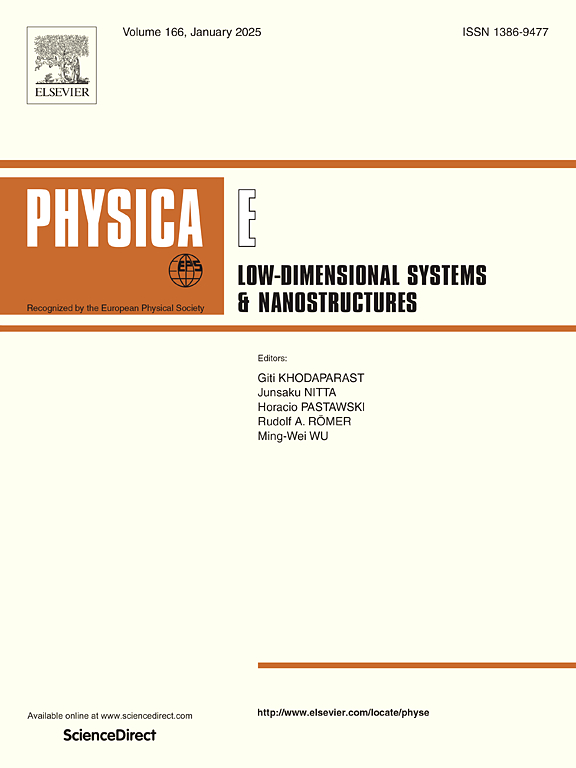Singlet-triplet splitting and Mollow triplet dynamics in impurity-doped core/shell quantum dots
IF 2.9
3区 物理与天体物理
Q3 NANOSCIENCE & NANOTECHNOLOGY
Physica E-low-dimensional Systems & Nanostructures
Pub Date : 2025-05-14
DOI:10.1016/j.physe.2025.116292
引用次数: 0
Abstract
While previous studies have explored singlet–triplet splitting in quantum dots with various geometries and material compositions for high-fidelity qubit design, core/shell QDs—particularly CdSe/CdS— have not been extensively investigated for this purpose. Given their advantageous optical properties, this study aims to investigate the electronic and optical behavior of a two-electron system confined in a CdSe/CdS core/shell QD modeled with a Woods–Saxon potential, incorporating a monovalent off-center impurity. We analyze how the singlet–triplet energy splitting depends on the core-to-shell size ratio and explore the system's response to external electric fields.
Using the effective mass approximation and perturbation theory, we show that for a core radius of 0.5 nm, increasing the shell thickness from 0.5 nm to 2 nm reduces the singlet–triplet splitting from 0.245 eV to 0.085 eV (a 65.3 % decrease). For a 2 nm core, the reduction is smaller—28.4 %—indicating weaker confinement effects. The dynamics under an external electric field reveal Rabi oscillations with tunable frequency and amplitude; increasing the field from 0.5 to 2 kV/cm shortens the oscillation period from ∼0.10 ps to ∼0.05 ps. At field strengths above 1.5 kV/cm, the triplet state becomes more probable than the singlet state during certain time intervals. We also analyze the Mollow triplet evolution and find that sideband separation grows proportionally with the Rabi frequency. These results highlight the tunability of singlet–triplet transitions in CdSe/CdS QDs, offering promising avenues for optical control in solid-state quantum information applications.
掺杂核壳量子点的单重态-三重态分裂和Mollow三重态动力学
虽然以前的研究已经探索了具有各种几何形状和高保真量子比特设计的材料组成的量子点中的单重态-三重态分裂,但核/壳量子点-特别是CdSe/ cd -尚未为此目的进行广泛研究。鉴于其优越的光学性质,本研究旨在研究包含一价偏离中心杂质的双电子系统的电子和光学行为,该系统被限制在具有Woods-Saxon势模型的CdSe/CdS核/壳量子点中。我们分析了单重态-三重态能量分裂如何依赖于核壳尺寸比,并探讨了系统对外部电场的响应。利用有效质量近似和微扰理论,我们发现当核半径为0.5 nm时,壳层厚度从0.5 nm增加到2 nm,单重态-三重态分裂从0.245 eV减少到0.085 eV(减少65.3%)。对于2nm的磁芯,衰减较小,为28.4%,表明约束效应较弱。外加电场作用下的动力学表现为频率和幅值可调的拉比振荡;当电场强度从0.5 kV/cm增加到2 kV/cm时,振荡周期从~ 0.10 ps缩短到~ 0.05 ps。当电场强度高于1.5 kV/cm时,在一定的时间间隔内,三重态比单线态更有可能发生。我们还分析了Mollow三重态的演化,发现边带分离随Rabi频率成比例增长。这些结果突出了CdSe/CdS量子点中单线态-三重态跃迁的可调性,为固态量子信息应用中的光控制提供了有希望的途径。
本文章由计算机程序翻译,如有差异,请以英文原文为准。
求助全文
约1分钟内获得全文
求助全文
来源期刊
CiteScore
7.30
自引率
6.10%
发文量
356
审稿时长
65 days
期刊介绍:
Physica E: Low-dimensional systems and nanostructures contains papers and invited review articles on the fundamental and applied aspects of physics in low-dimensional electron systems, in semiconductor heterostructures, oxide interfaces, quantum wells and superlattices, quantum wires and dots, novel quantum states of matter such as topological insulators, and Weyl semimetals.
Both theoretical and experimental contributions are invited. Topics suitable for publication in this journal include spin related phenomena, optical and transport properties, many-body effects, integer and fractional quantum Hall effects, quantum spin Hall effect, single electron effects and devices, Majorana fermions, and other novel phenomena.
Keywords:
• topological insulators/superconductors, majorana fermions, Wyel semimetals;
• quantum and neuromorphic computing/quantum information physics and devices based on low dimensional systems;
• layered superconductivity, low dimensional systems with superconducting proximity effect;
• 2D materials such as transition metal dichalcogenides;
• oxide heterostructures including ZnO, SrTiO3 etc;
• carbon nanostructures (graphene, carbon nanotubes, diamond NV center, etc.)
• quantum wells and superlattices;
• quantum Hall effect, quantum spin Hall effect, quantum anomalous Hall effect;
• optical- and phonons-related phenomena;
• magnetic-semiconductor structures;
• charge/spin-, magnon-, skyrmion-, Cooper pair- and majorana fermion- transport and tunneling;
• ultra-fast nonlinear optical phenomena;
• novel devices and applications (such as high performance sensor, solar cell, etc);
• novel growth and fabrication techniques for nanostructures

 求助内容:
求助内容: 应助结果提醒方式:
应助结果提醒方式:


